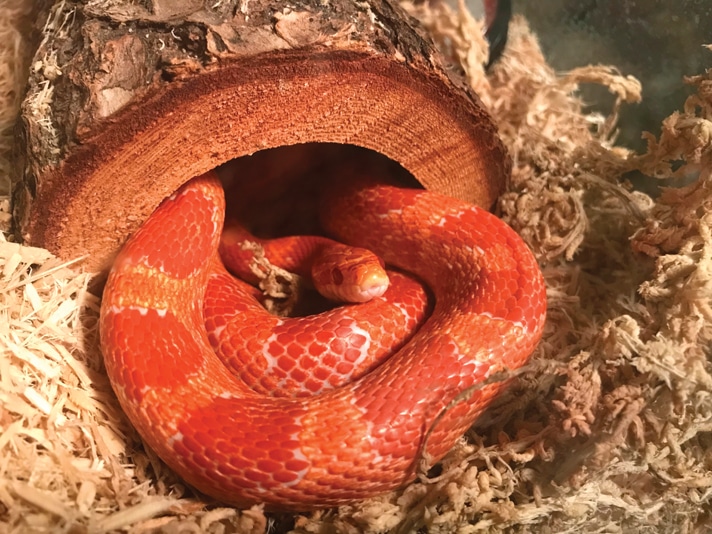With good research and proper care, any of these snakes would make for a great captive.
Snakes are very popular with reptile keepers. This article comprises 10 popular snake species in reptile keeping, and all make great pets with the right information. With the exception of the egg-eater, all these snakes are consistently captive-bred and should be easy to locate at reptile specialty stores, on the Internet and at reptile shows. There is no real rhyme or reason to the order I put these snakes in.
Corn Snake (Pantherophis guttatus)
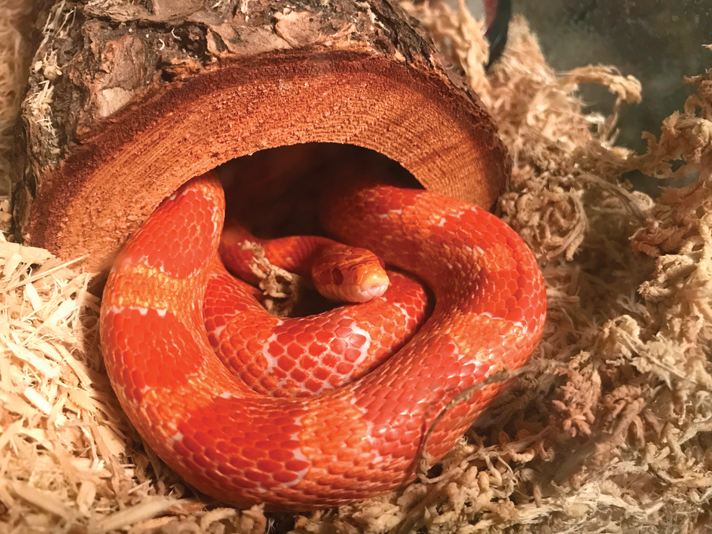
Vince Bradley/Shutterstock
Corn snakes are one of the most popular snakes with reptile keepers.
Corn snakes have been a staple in the reptile-keeping hobby since the late 70s. And their popularity is still going strong. I can’t think of a single negative about keeping a corn snake.
Easy to Keep: Corn snakes require very little in housing. A 30-gallon flat tank will house an adult or two for life. Bedding is as simple as aspen bedding. Add a water bowl, a humid hide (a cave or curved log with some damp moss inside it) and feed them. A heat pad under one end of the enclosure is just about the only heating they need.
Easy to Feed: Corn snakes feed very well on pre-killed or frozen/thawed mice, and some, when larger, can be fed small rats. Hatchling corn snakes are also easy to keep and can be fed frozen/thawed pinky mice.
Easy on the Eyes: Corn snakes come in a vast array of colors, patterns and styles. And the number of various morphs seems to keep growing each year. When I think there can’t be any new color mutations, a new one pops up.
Easy to handle: It’s very rare to find a mean corn snake. Most are, in fact, very mellow, and although I’m sure it’s not true, they sometimes seem to want to be held. They move with a smooth motion in your hands and seem to glide across your hands when loosely held. Although all snakes bite, corn snakes just tend not to.
In my view, the corn snake may just be the perfect pet snake.
Ball Python (Python regius)
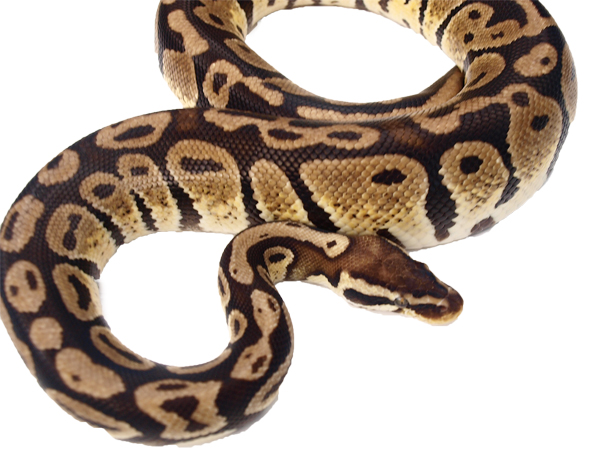
bluedog studio/Shutterstock
Some say that the ball python has surpassed the corn snake in popularity with reptile keepers. This is a pair of bumble bee ball pythons.
The ball python has almost replaced corn snakes in world-wide popularity. Just like corns, ball pythons come in a huge assortment of colors and patterns, with new morphs popping up every year. Once upon a time, all you could find were wild-caught balls. They were hard to acclimate and hard to get them to feed. And then the first albino ball python crawled into our lives, and the rest is history.
Easy to Keep: Ball pythons are undemanding as long as their basic needs are met. Males tend to be smaller than females and can be kept in smaller enclosures than females. A basic set up would be a 3-feet long by 1.5-foot wide by 1-foot high enclosure.
Aspen, cypress or orchid bark makes a good substrate. A roomy water bowl, a humid hide and a dry hide, and a few decorations are an easy set up. A heat pad at one end of the enclosure is pretty much all you need for heat. Put the humid hide over the heat pad. This will help deploy humidity to the enclosure and keep your python nice and comfy. Humidity is important to this species, so try to keep the humidity at 60% or more, if possible. If you see your python sitting in its water bowl all the time, check your humidity. The enclosure might be too dry.
Easy to feed: Unlike the old import days, ball pythons are now captive-bred in huge numbers. Most feed readily on pre-killed or frozen/thawed mice and rats. Yes, sometimes they will fast for a few months (we tend to over feed ball pythons, all of us!), but this is normal. Keep in mind that in the wild, ball pythons tend to eat three, or perhaps four times a year.
Easy on the Eyes: I can’t even think of how many color and pattern morphs of ball pythons there are—perhaps hundreds! Seems like a few new morphs pop up every year. I can still remember seeing my very first Mojave ball python (with a $50,000 price tag). Such a beautiful snake, and thankfully they now sell for about $100 each, depending on sex and size.
Easy to handle: Personally, I find ball pythons to be a bit boring. And this is exactly what makes them so appealing. They are not fast and tend to hold still, in fact. They hang out in their hide most of the day, usually only venturing out at night. They are very easy to handle and rarely bite (all snakes can and might bite). As stated, ball pythons mostly move about their enclosures at night, and if not secured properly, they are great at escaping. Keep these cages locked down! Besides the fact they don’t move much, these are great snakes.
California and Other Common Kingsnakes (Lampropeltis Spp.)
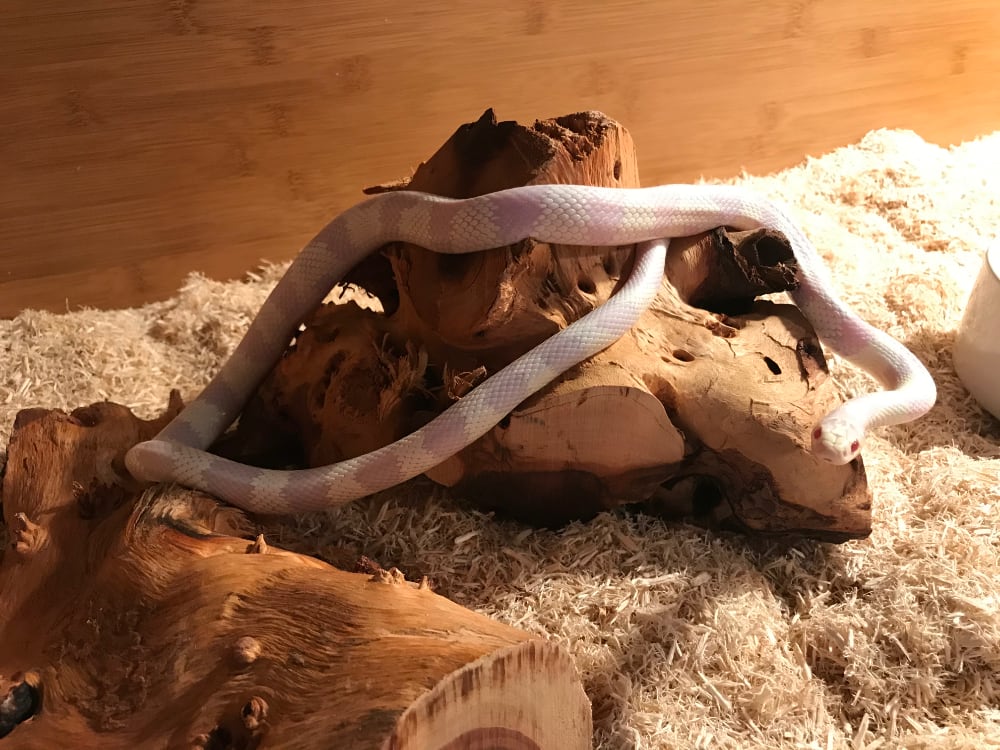
Photo by John Virata
Easy to Keep: You can keep most of these snakes just like corn snakes. Aspen bedding in a 3-feet long by 1-foot wide by 1-foot high enclosure works well, with a water bowl, hide, perhaps a few sticks to climb around on and a heat pad under one end of the tank. Depending on the species you select, you might need a bit larger enclosure, as there’s a real difference in size between a California kingsnake and an eastern or Florida kingsnake. Also, the eastern species tend to need a bit more humidity than the western species. A humid hide works well for the more humid-loving species.
Easy to feed: All members of this group of snakes take pre-killed or frozen/thawed mice and rats very well, including hatchlings.
Easy on the Eyes: California kingsnakes come in a nice variety of colors and a few different patterns, but in my view, nothing beats a natural colored black and white-banded Cal king. They are stunning. But they also come in cream, brown, white, yellow and purple. Some have bands, some have stripes and some come in a combination of both. High-white Cal kings are very attractive. And some of the other kingsnakes also come in all kinds of colors and patterns. There’s an amazing variety for everyone’s taste.
Easy to handle: Although kingsnakes tend to be a bit more active than corn snakes, and more active than ball pythons, these are still easy-to-handle snakes. Hold them loosely and let them glide in your hands.
If there’s a downside to keeping kingsnakes, the only one would be that young ones tend to poop on you as a form of defense. They usually outgrow this habit over time and once they realize you are not going to eat them.
Rosy Boa (Lichanura trivirgata)
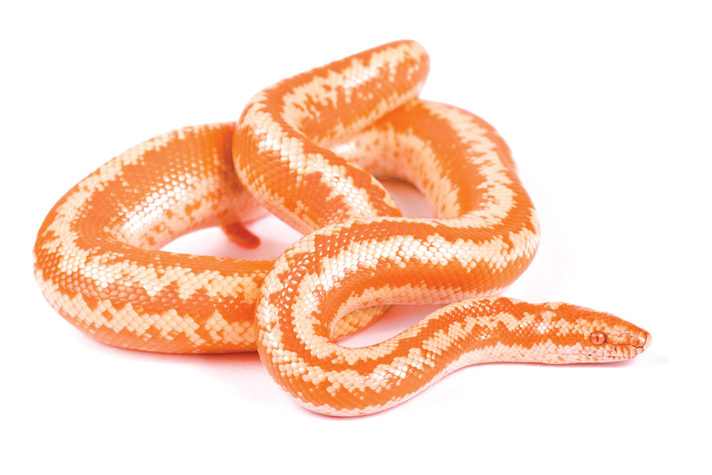
reptiles4all/Shutterstock
The rosy boa is a stunning small boa that comes in a variety of colors.
Easy to keep: Rosy boas are undemanding in their captive habitat. They tend to stay under 3 feet and, like ball pythons, are usually nocturnal. So, once again, an enclosure about 3-feet long by 1-foot wide by 1-foot high works. Aspen bedding is great for the substrate, and add enough so it has room to burrow.
A water bowl and a hiding place is a must. A humid hide would be welcome for this otherwise desert-living snake. A heat pad at one end of the tank works great for heat for this species.
Easy to feed: As with all the others, these feed very well on pre-killed or frozen/thawed mice. They rarely ever get large enough to eat rats.
Easy on the Eyes: Rosy boas are truly beautiful no matter the subspecies or color. They range from pink, brown, and cream, to striped, speckled and albino.
Easy to handle: These are usually slow-moving snakes and are easy to handle. They seem content to sit in your hands and chill. They rarely bite, but as with all snakes, they sure can if they feel they need to defend themselves.
Gopher, Pine and Bull Snakes (Pituophis sp.)
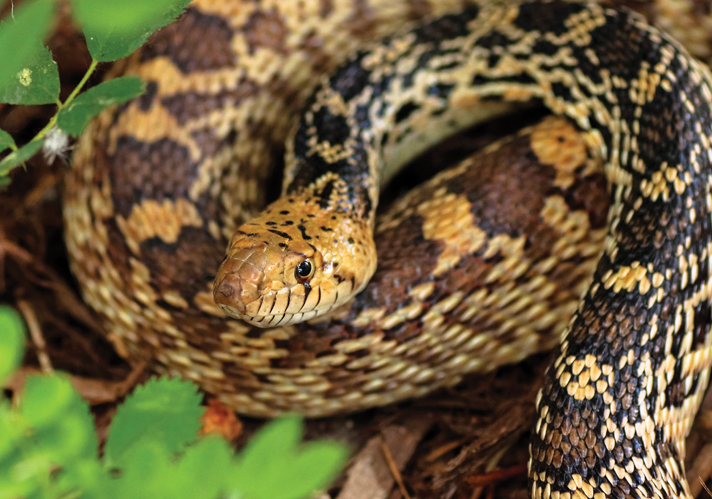
Rose Ludwig/Shutterstock
Bull snakes (Pituophis catenifer sayi) can grow to more than six feet in length.
Easy to Keep: This group of snakes range in size from 3 feet up to almost 7 feet. Because of this, there’s a large difference in enclosure size. A 3-foot Pacific gopher snake would do well in a simple 20-gallon long tank, whereas a large bull snake will require a 60-gallon terrarium. Remember that babies grow up, so plan ahead depending on what type of snake you decide to get. A simple set up of aspen bedding, a water bowl and a hide works great. A heat pad under one end of the enclosure completes the set up.
Easy to feed: I have found that most adult Pituophis do well on pre-killed or frozen/thawed rats. Babies will need to be started on mice, but all usually get large enough to handle at least a small rat.
Easy on the Eyes: Gopher, pine and bull snakes come in a variety of colors, interesting patterns and of course sizes. The big northern pine snake can come in a stark black and white color, Pacific gopher snakes can come in reticulated or striped patterns. There are albinos of just about all of them, including the beautiful bright yellow Sonoran gopher snake.
Easy to handle: Some of these, such as the big northern pine and the even bigger bull snakes from Texas and other areas tend to get big. These are two-handed snakes, meaning you will need two hands to hold an adult.
They are usually mellow snakes and rarely, if ever, bite. They do sometimes emit a loud hiss and might even strike. The strike is generally a bluff, as they usually just hit you with their nose, mouth closed. This is an interesting group of snakes. They are usually big and active and fun to watch and keep.
Western Hognose Snake (Heterodon nasiscus nasiscus)
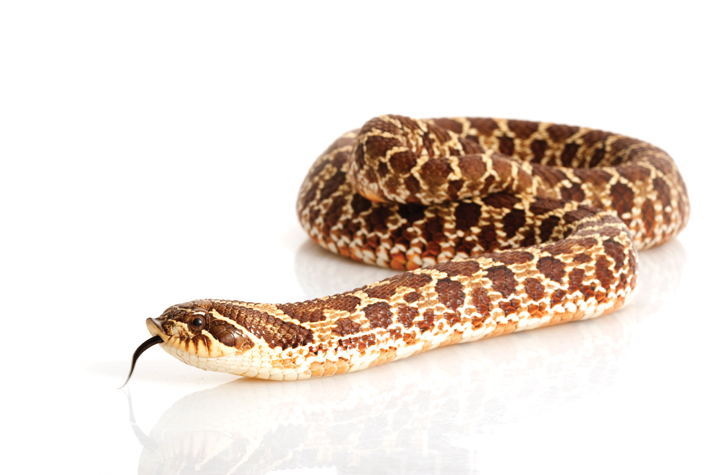
fivespots/Shutterstock
The western hognose snake is a small snake that has gained popularity in recent years thanks to an array of colorations available.
Easy to Keep: Heterodon nasiscus nasiscus tends to stay under 2-feet long, with females getting larger than males. Either sex can be maintained in a 30-inch by 12-inch by 12-inch enclosure. Aspen bedding is good for substrate. A water bowl, hide and a heat pad at one end completes the setup.
Easy to feed: Although newborns tend to start off eating lizards, once they convert to mice they are really easy to keep. Make sure that you ask if your prospective baby hognose is feeding on frozen/thawed pinky mice. Once established on mice, pre-killed or frozen/thawed will be taken readily. They are small, so an average-sized adult mouse is all you’ll need to feed them in their adult lifetime.
Easy on the eyes: Western hognose snakes come in a variety of colors and patterns. There are yellow albinos, red albinos, anaconda pattern phases and many more. These are beautiful snakes, and I can’t think of any snake more pretty than a big adult female albino hognose snake.
Easy to handle: This tends to be a somewhat slow snake. They handle very well, preferring to sit in your hand than to make a run for it. When stressed, they may flair their neck, and under extreme conditions, might even play dead—but this is rare in captive animals.
Some people have an allergic reaction to their saliva, so try to keep your fingers out of their months. The reaction might cause localized swelling, but that’s about it. These are great pet snakes. The western hognose is small, slow and easy to keep.
African Egg-Eating Snake (Dasypeltis scabra)
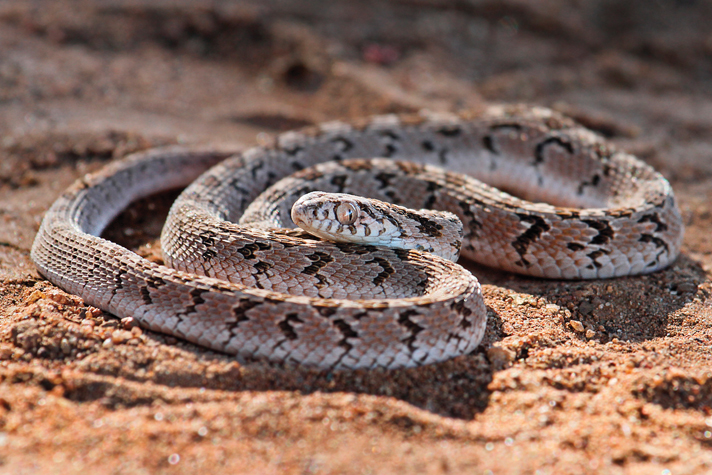
Eugene Troskie/Shutterstock
Egg-eaters are active but tame down quickly with handling.
Easy to Keep: Egg-eaters tend to stay small and rather slender. They come from Africa and near Asia and can be found in everything from arid to temperate habitats. But keeping them is not complicated. A 20-gallon enclosure with a bark substrate works well. A water bowl and a few hides will make them comfortable, along with a few sticks and branches to climb and stretch out on. A heat pad at one end so they can thermoregulate works well.
Easy on the Eyes: Although I’m not aware of any color morphs, these do come in different shades of earth tone and cream colors, depending on locality. They are very pleasing to look at.
Easy to feed: This is likely the perfect pet snake. The only reason I don’t list it as #1 is because all they eat are eggs, hence the name. The reason it should be #1 is because all they eat are eggs. No mice, no lizards, no live food.
But this is a small snake, and quail eggs tend to be about the largest eggs they will eat. Fortunately, you can get quail eggs at Asian markets in the town you live it, so feeding is not so much a problem. We’ve housed babies that are too small for quail eggs, so we feed them finch eggs. So the only problem is finding a supply of tiny eggs for the smaller specimens.
They swallow the eggs whole, drain the contents and puke up the shell. No muse, no fuss. Nice and easy. I buy quail eggs a dozen at a time and keep them in the fridge. Just take one out and let it set at room temperature for an hour. Give it to them and they do the rest.
Easy to handle: Egg-eaters are active but tame down quickly with handling. They are non-aggressive and don’t seem to bite but of course can. I’ve always wanted to hand-feed one, but the ones I’ve had would rather feed themselves off the ground. They sure are cool.
This is a very mellow and interesting snake. Watching them eat in person is very cool, amazing even. If you can find small enough eggs, they are just about the perfect snake for those who object to feeding animals to snakes but still want a snake.
Common Boa Constrictor: (Boa constrictor)
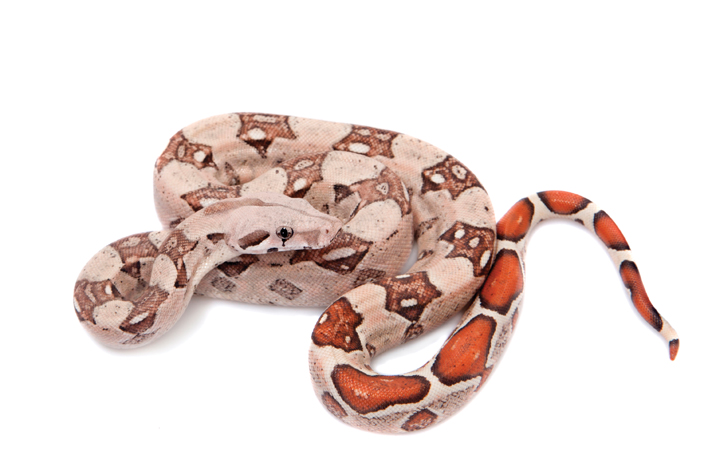
Rosa Jay/Shutterstock
Of this group of snakes, the Boa constrictors grow the largest.
Easy to Keep: Boas. The name makes huge snakes come to mind, and this is really true. Boas can range in size from 5- to 10-feet in length. Some really big ones can be up to 12 feet, but that tends to be rare. Either way, you’ll need a fairly large enclosure. Baby boas can be kept in something as small as a 10-gallon tank, but they will quickly outgrow something so small. A large female would do nicely in something like a 5-feet long by 2-feet tall by 2-feet high enclosure with a heavy-duty screen top.
The entire set up is pretty easy. Bark or aspen on the bottom with a large water bowl and a heat pad at one end. Temps need to stay at above 70 degrees at night, so keep that in mind when providing a hot spot. I tend to not provide a hide for large constrictors, but this is a personal preference and you might prefer otherwise.
Easy on the Eyes: Boas come in a large number of colors and patterns. There are locality differences. Some have such red tails they almost look purple. Albinos are just stunning. Anery boas are very attractive in a muted way. Hogg Island boas are light colored and are natural dwarfs, rarely getting over 3 feet in length. Hypo boas are just stunning. Take your pick. They are all cool.
Easy to feed: Boas eat pre-killed or frozen/thawed rodents. Baby boas can start off on small adult mice, and the largest ones can be fed jumbo rats or even small rabbits. Feeding is easy, and I suggest you move the snake to a secondary “feeding” enclosure to avoid a feeding response every time you want to handle the snake. Mistakes happen. Don’t allow the snake to mistake your hand for food.
Easy to handle: The only drawback of keeping a large boa (or python for that matter) is size. These snakes can get big, and even a 5-foot male Boa is a big, hefty snake. They are strong and like to secure themselves from falling by wrapping around your hands and arms. But all in all, they are mellow, tend not to bite and will just relax with you.
Boas make very gratifying charges. They come in stunning colors and a normal colored one can’t be beat. They do get big. So they take up a bit more space. But they are worth it.
Checkered Garter Snake (Thamnophis marcianus)
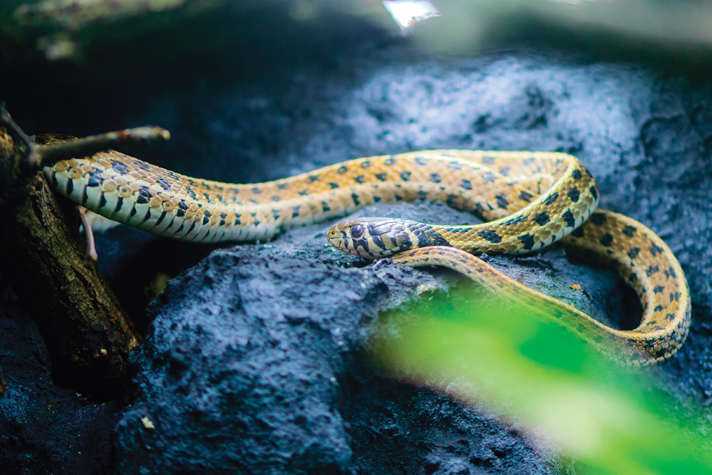
Yurkovski/Shutterstock
Garter snakes are often overlooked as pets but they are certainly beautiful.
Easy to Keep: Checkered garters are really neat. Housing them is easy, too. Females get larger than males, but both sexes can easily be kept in a 20-gallon long terrarium. Aspen bedding for a substrate is great along with a water bowl, a hide or two and a heat pad at one end of the enclosure. They like to explore, so add some branches or other things they might be interested in checking out.
Easy to feed: Most baby checkered garters start off eating fish. Guppies are usually good starter food. But it doesn’t take much in the way of guppies to get them big enough to start on pinky mice. And they will readily accept frozen/thawed pinkies. My adults feed exclusively on pre-killed or frozen/thawed adult mice. I just toss the mouse in the cage and the garter does the rest, quickly. They are ravenous feeders.
Easy on the Eyes: Checkered garters are beautiful in their natural color. And they are stunning as albinos. They tend to be yellow and white and almost look like they glow.
Easy to handle: Although this snake tends to have a feeding response, once they realize you don’t have food they mellow out fast. They are quick but tend to take being handled well. These are smart snakes and will know you.
This is a beautiful, often overlooked snake. They accept rodents well and are easy to keep.
Baird’s Rat Snake (Elaphe bairdi)
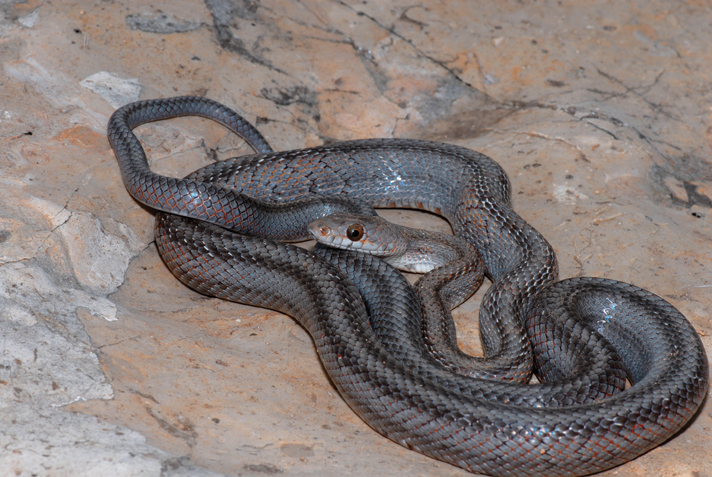
Rusty Dodson/Shutterstock
The Baird’s rat snake is captive-bred and is a very attractive snake. The Baird’s rat snake grows to about 3 feet in length. They are native to Texas and New Mexico.
Easy to keep: This is a very attractive snake found in Texas and New Mexico, down into Mexico. They live in drier habitats (usually). You can set them up in a standard enclosure. They can get about 3-feet long, so a tank that’s 3-feet long by 1-foot wide by 1-foot high will be fine for one or two. Aspen bedding is cheap and easy, so I like to use that on a lot of these snakes. A water bowl, hide and a heat pad under one end rounds out the setup.
Easy to feed: These snakes tend to start off well on pinky mice and eventually can likely take on a small rat. But large mice are just fine, too. They will readily take pre-killed or frozen/thawed.
Easy on the Eyes: Baird’s rat snakes start off with a blotched pattern as babies. As they grow, their pattern changes, usually with two stripes running down the length of their body. The most beautiful ones are copper-colored or look like brushed aluminum. They are stunning. There are also now albinos out there, but nothing beats the natural metallic colors that nature gave them.
Easy to handle: These are active snakes. They tend to be inoffensive and rarely, if ever, bite. They will cruise about quickly and will slide through your hands as you hold them. They are fun to hold. This is one of the most beautiful snakes around. Another very unappreciated snake that should be kept by more people.
Conclusion
As always, do your research before adding a reptile to your collection, including proper care and knowing your local ordinances, as some localities don’t allow for certain snakes or require permits to keep them.

